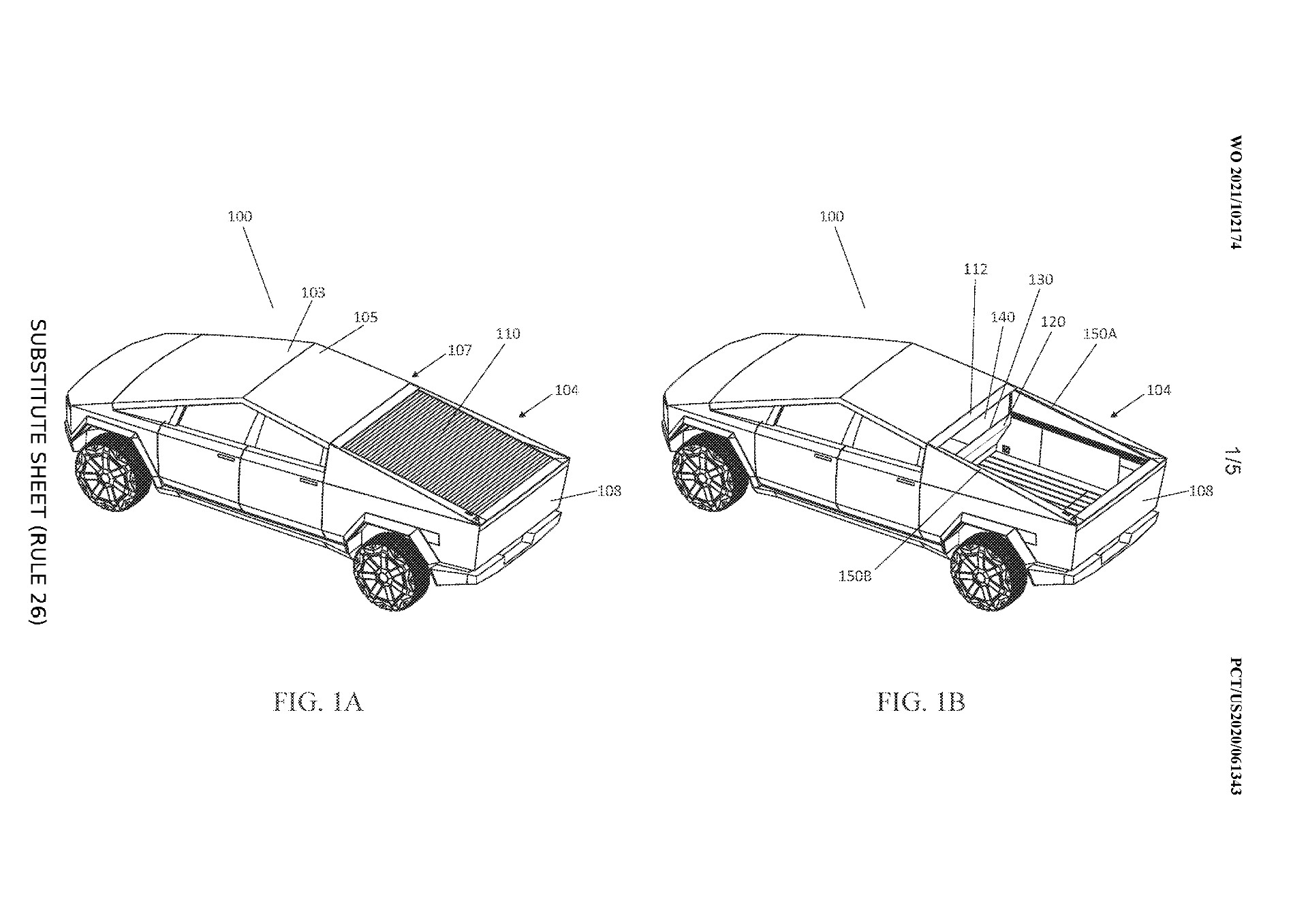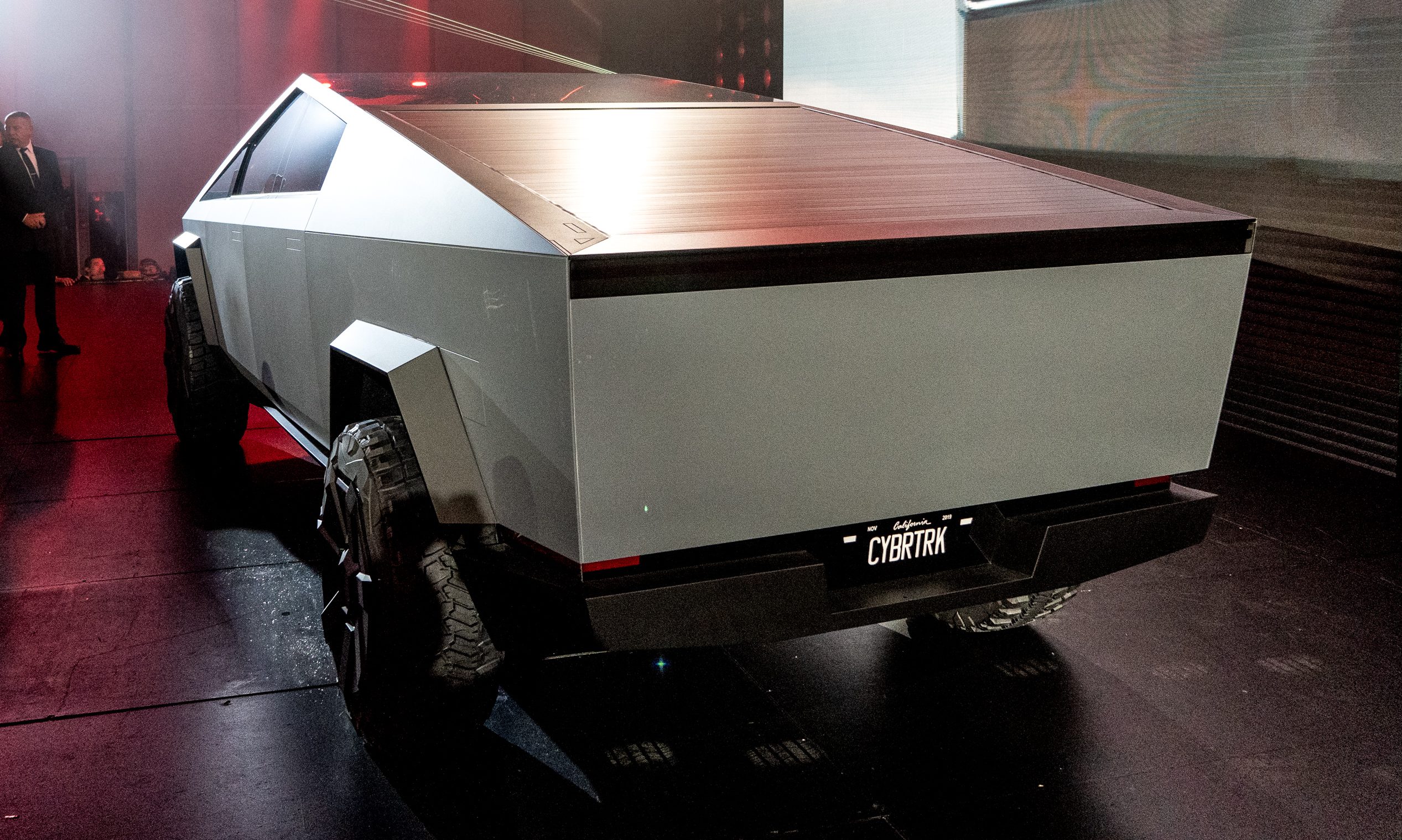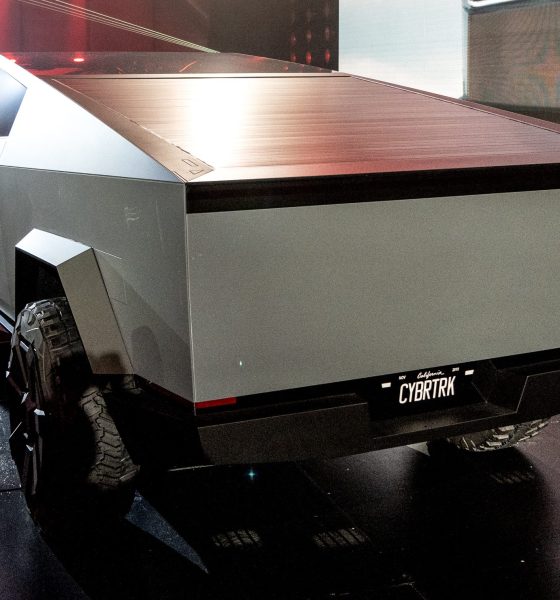The Tesla Cybertruck’s many features are now appearing as patents that the automaker has submitted to the United States Patent Office, and one of the most notable is the tonneau, or truck bed cover. While the retractable design of the tonneau provides convenience at the touch of a button for owners, it will protect any goods or cargo that drivers will store in the Cybertruck’s massive bed. However, the design is now hinting toward even more versatility and usefulness as the patent describes the potential use as a solar panel that will provide range for the all-electric truck by capturing the sun’s energy.
In Tesla’s newly published “Integrated Tonneau Cover for a Vehicle” patent, several inventors submit their idea and designs for the Cybertruck’s fully mechanical tonneau cover. Guided along a set of channels in the bed of the truck, the tonneau cover will provide protection for any cargo that is stored in the back of the vehicle. Whether it be tools or luggage, the tonneau cover is Tesla’s way of giving owners a way to protect their belongings without having to purchase expensive aftermarket bed covers, which other trucks do not provide. The retractable tonneau is shown in the images below.
Credit: US Patent Office
“In order to mitigate the possibility of such damage, many truck owners install aftermarket truck bed covers that cover the bed of their truck,” the patent states. “However, not only may such aftermarket truck bed covers be difficult to install, they also may not fit exactly with the specifications of the truck beds of different models of trucks. If a truck bed cover does not have an accurate fit it can leak rain or snow through the gaps between the truck bed cover and the walls around the truck bed, and cause cargo damage. In addition, not only are many aftermarket truck bed covers difficult to install and inconvenient to use, but they also take up space in the truck beds and reduce the overall utility of the trucks.”
The tonneau, in a revolutionary new design, will also be able to recharge the vehicle’s battery pack thanks to 110 solar electric cells that are electrically connected to a photovoltaic charging system and battery. “When the tonneau cover is deployed to cover the bed and the solar electric cells that make up the slats are facing the sun, the battery within the electric vehicle can be charged by solar electric cells,” the patent states.
While solar panels on an electric vehicle have been looked at as a possibility in the past, the idea has never come to fruition due to ineffectiveness. Because a car doesn’t provide much surface area, to begin with, the contribution of charge from solar panels would be minimal, and it would require extremely clear and favorable weather conditions to provide any effective additional range to the vehicle. However, CEO Elon Musk hinted just days after the Cybertruck’s unveiling event in November 2019 that Tesla would be adding an option to add solar power that could generate up to 15 miles per day. Musk also hinted toward “fold-out solar wings” that could generate an additional 30-40 miles per day, which could alleviate the need to stop at a Supercharger for some owners.
Will be an option to add solar power that generates 15 miles per day, possibly more. Would love this to be self-powered. Adding fold out solar wings would generate 30 to 40 miles per day. Avg miles per day in US is 30.
— Elon Musk (@elonmusk) November 22, 2019
The tonneau would be completely covered in solar electric cells, and the patent claims that when the “truck bed cover is in a closed position, it is configured to recharge the battery pack, the closed position of the truck bed cover enabling the plurality of solar electric cells to face a sun.”
Musk also hinted toward the possibility of installing solar cells on the roof of a potential Tesla van with Joe Rogan in a podcast interview earlier this year. Musk said that the van would be a favorable design due to its “big, flat area,” and “solar could start to make a little more sense.” Because the tonneau is flat and covers a considerable surface area, there is some potential for it to be just as effective as Musk’s idea for the van.
The full patent document is available below.
Tesla Cybertruck Tonneau Solar Patent by Joey Klender on Scribd

News
Tesla FSD fleet is nearing 7 billion total miles, including 2.5 billion city miles
As can be seen on Tesla’s official FSD webpage, vehicles equipped with the system have now navigated over 6.99 billion miles.

Tesla’s Full Self-Driving (Supervised) fleet is closing in on almost 7 billion total miles driven, as per data posted by the company on its official FSD webpage.
These figures hint at the massive scale of data fueling Tesla’s rapid FSD improvements, which have been quite notable as of late.
FSD mileage milestones
As can be seen on Tesla’s official FSD webpage, vehicles equipped with the system have now navigated over 6.99 billion miles. Tesla owner and avid FSD tester Whole Mars Catalog also shared a screenshot indicating that from the nearly 7 billion miles traveled by the FSD fleet, more than 2.5 billion miles were driven inside cities.
City miles are particularly valuable for complex urban scenarios like unprotected turns, pedestrian interactions, and traffic lights. This is also the difference-maker for FSD, as only complex solutions, such as Waymo’s self-driving taxis, operate similarly on inner-city streets. And even then, incidents such as the San Francisco blackouts have proven challenging for sensor-rich vehicles like Waymos.
Tesla’s data edge
Tesla has a number of advantages in the autonomous vehicle sector, one of which is the size of its fleet and the number of vehicles training FSD on real-world roads. Tesla’s nearly 7 billion FSD miles then allow the company to roll out updates that make its vehicles behave like they are being driven by experienced drivers, even if they are operating on their own.
So notable are Tesla’s improvements to FSD that NVIDIA Director of Robotics Jim Fan, after experiencing FSD v14, noted that the system is the first AI that passes what he described as a “Physical Turing Test.”
“Despite knowing exactly how robot learning works, I still find it magical watching the steering wheel turn by itself. First it feels surreal, next it becomes routine. Then, like the smartphone, taking it away actively hurts. This is how humanity gets rewired and glued to god-like technologies,” Fan wrote in a post on X.
News
Tesla starts showing how FSD will change lives in Europe
Local officials tested the system on narrow country roads and were impressed by FSD’s smooth, human-like driving, with some calling the service a game-changer for everyday life in areas that are far from urban centers.

Tesla has launched Europe’s first public shuttle service using Full Self-Driving (Supervised) in the rural Eifelkreis Bitburg-Prüm region of Germany, demonstrating how the technology can restore independence and mobility for people who struggle with limited transport options.
Local officials tested the system on narrow country roads and were impressed by FSD’s smooth, human-like driving, with some calling the service a game-changer for everyday life in areas that are far from urban centers.
Officials see real impact on rural residents
Arzfeld Mayor Johannes Kuhl and District Administrator Andreas Kruppert personally tested the Tesla shuttle service. This allowed them to see just how well FSD navigated winding lanes and rural roads confidently. Kruppert said, “Autonomous driving sounds like science fiction to many, but we simply see here that it works totally well in rural regions too.” Kuhl, for his part, also noted that FSD “feels like a very experienced driver.”
The pilot complements the area’s “Citizen Bus” program, which provides on-demand rides for elderly residents who can no longer drive themselves. Tesla Europe shared a video of a demonstration of the service, highlighting how FSD gives people their freedom back, even in places where public transport is not as prevalent.
What the Ministry for Economic Affairs and Transport says
Rhineland-Palatinate’s Minister Daniela Schmitt supported the project, praising the collaboration that made this “first of its kind in Europe” possible. As per the ministry, the rural rollout for the service shows FSD’s potential beyond major cities, and it delivers tangible benefits like grocery runs, doctor visits, and social connections for isolated residents.
“Reliable and flexible mobility is especially vital in rural areas. With the launch of a shuttle service using self-driving vehicles (FSD supervised) by Tesla in the Eifelkreis Bitburg-Prüm, an innovative pilot project is now getting underway that complements local community bus services. It is the first project of its kind in Europe.
“The result is a real gain for rural mobility: greater accessibility, more flexibility and tangible benefits for everyday life. A strong signal for innovation, cooperation and future-oriented mobility beyond urban centers,” the ministry wrote in a LinkedIn post.
News
Tesla China quietly posts Robotaxi-related job listing
Tesla China is currently seeking a Low Voltage Electrical Engineer to work on circuit board design for the company’s autonomous vehicles.

Tesla has posted a new job listing in Shanghai explicitly tied to its Robotaxi program, fueling speculation that the company is preparing to launch its dedicated autonomous ride-hailing service in China.
As noted in the listing, Tesla China is currently seeking a Low Voltage Electrical Engineer to work on circuit board design for the company’s autonomous vehicles.
Robotaxi-specific role
The listing, which was shared on social media platform X by industry watcher @tslaming, suggested that Tesla China is looking to fill the role urgently. The job listing itself specifically mentions that the person hired for the role will be working on the Low Voltage Hardware team, which would design the circuit boards that would serve as the nervous system of the Robotaxi.
Key tasks for the role, as indicated in the job listing, include collaboration with PCB layout, firmware, mechanical, program management, and validation teams, among other responsibilities. The role is based in Shanghai.
China Robotaxi launch
China represents a massive potential market for robotaxis, with its dense urban centers and supportive policies in select cities. Tesla has limited permission to roll out FSD in the country, though despite this, its vehicles have been hailed as among the best in the market when it comes to autonomous features. So far, at least, it appears that China supports Tesla’s FSD and Robotaxi rollout.
This was hinted at in November, when Tesla brought the Cybercab to the 8th China International Import Expo (CIIE) in Shanghai, marking the first time that the autonomous two-seater was brought to the Asia-Pacific region. The vehicle, despite not having a release date in China, received a significant amount of interest among the event’s attendees.










